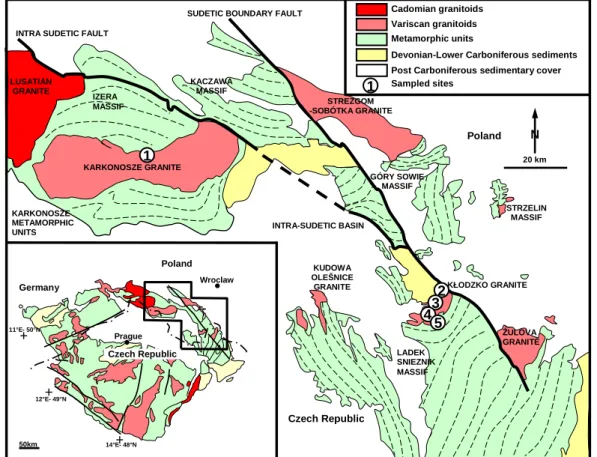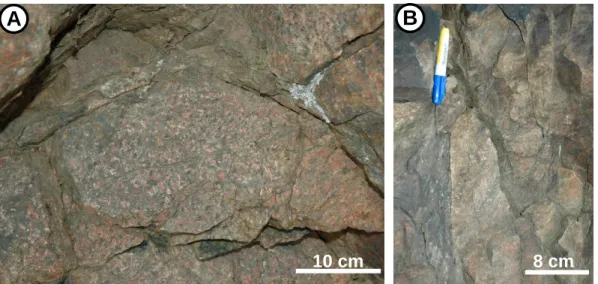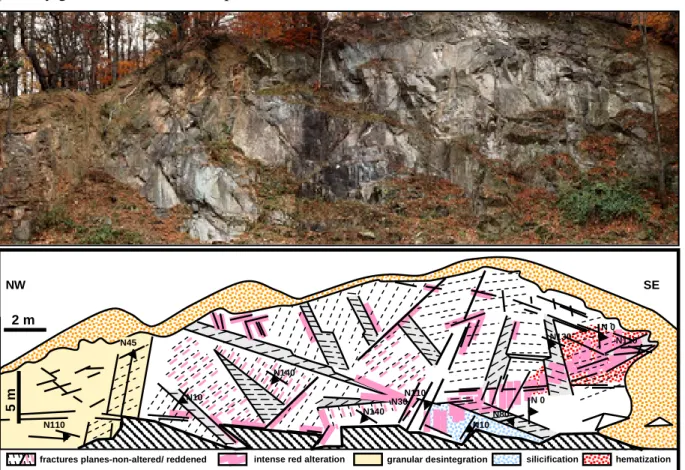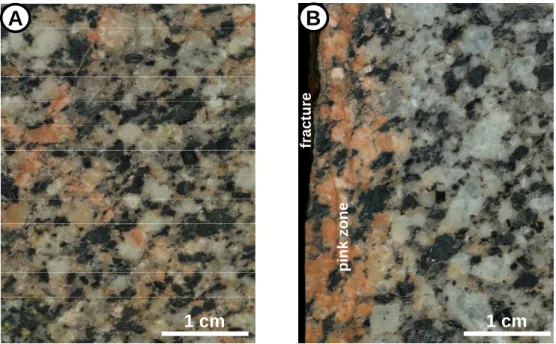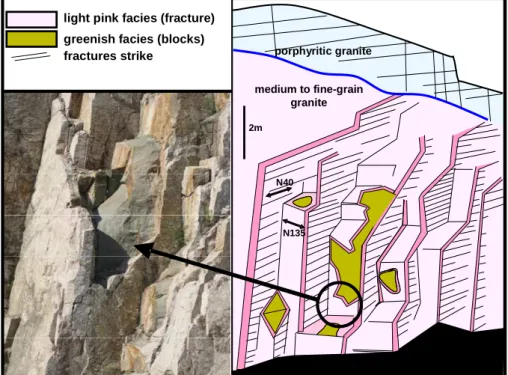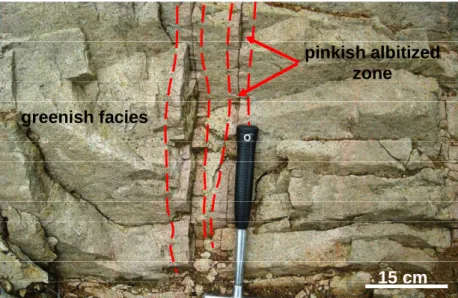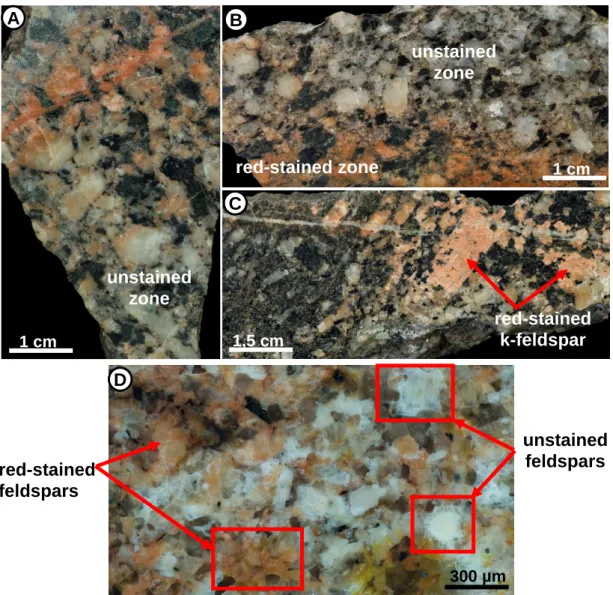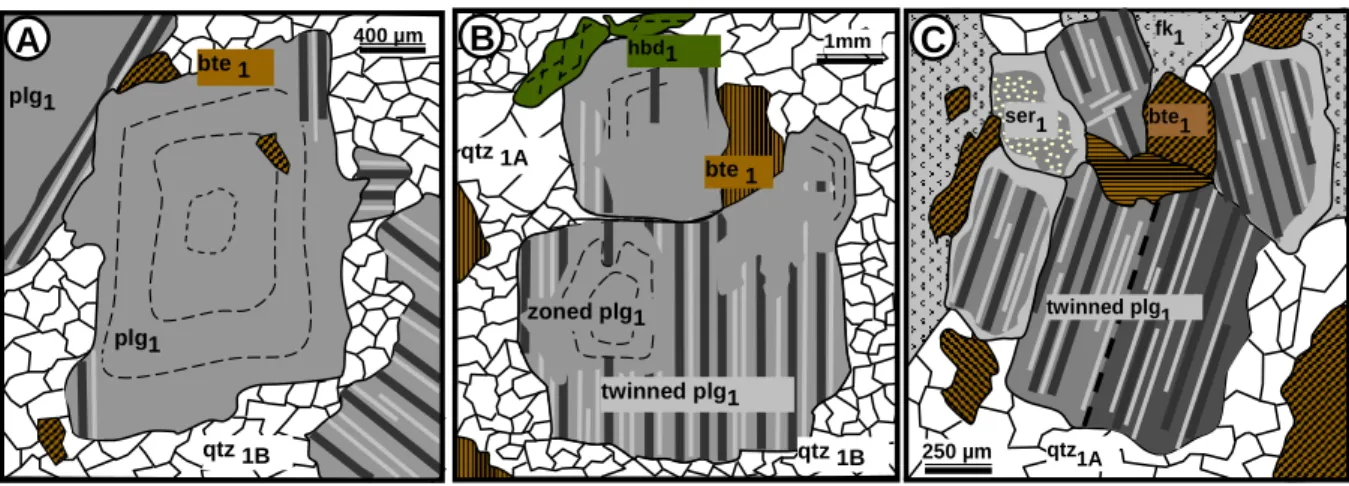HAL Id: pastel-00971314
https://pastel.archives-ouvertes.fr/pastel-00971314
Albitisation et oxydation des roches granitoïdes en
relation avec la paléosurface triasique des Sudètes (SW
Pologne)
Kouakou Fulgence Eric Yao
To cite this version:
Kouakou Fulgence Eric Yao. Albitisation et oxydation des roches granitoïdes en relation avec la paléosurface triasique des Sudètes (SW Pologne). Sciences de la Terre. Ecole Nationale Supérieure des Mines de Paris; Państwowy Instytut Geologiczny (Pologne), 2013. Français. �NNT : 2013ENMP0069�. �pastel-00971314�
Jury
Mme Isabelle COJAN, Doct., HDR, Geosciences, MINES ParisTech, Fontainebleau, France Présidente
Mme Katarzyna JARMOLOWICZ-SZULC, PhD, DHabil, Polish Geol. Inst.- NRI, Warsaw, Poland Co-Présidente
M. Pawel ALEKSANDROWSKI, PhD, DHabil, Polish Geol. Inst.-Nat. Res. Inst., Warsaw, Poland Examinateur
M. Anicet BEAUVAIS, Doct., HDR, CEREGE, Univ. of Aix-Marseille, Aix en Provence, France Rapporteur
Mme Christine FRANKE, PhD, Geosciences, MINES ParisTech, Fontainebleau, France Examinatrice
M. David PARCERISA, PhD, Polytechnical University of Catalonia, Manresa, Spain Examinateur
M. Jean-Michel SCHMITT, Doct. és Sc., AREVA, Geosciences Dpt., Paris la Défense, France Rapporteur
M. Adam SZUSZKIEWICZ, PhD, Inst. of Geological Sciences, University of Wroclaw, Poland Examinateur
T
H
È
S
E
Doctorat ParisTech
T H È S E
pour obtenir le grade de docteur préparée dans le cadre d’une cotutelle entre
l’École nationale supérieure des mines de Paris et
Pa
ń
stwowy Instytut Geologiczny - Pa
ń
stwowy Instytut Badawczy
à Varsovie, Pologne
Spécialité “Dynamique et Ressources des Bassins Sédimentaires”
Directeurs de thèse : Médard THIRY (MINES ParisTech)
Pawel ALEKSANDROWSKI (Polish Geological Institute-National Research Institute)
Co-encadrante : Christine FRANKE (MINES ParisTech)
École doctorale n° 398 : Géosciences et Ressources Naturelles
soutenue publiquement le 16 décembre 2013 par
Kouakou Fulgence Eric YAO
Albitization and oxidation of the granitoïd rocks
related to the Triassic paleosurface in the Sudetes (SW Poland)
Albitisation et oxydation des roches granitoïdes
en relation avec la paléosurface triasique des Sudètes (SW Pologne)
Zjawiska albityzacji i oksydacji skał granitoidowych związane z triasową powierzchnią zrównania w Sudetach (południowo-zachodnia Polska)
AVANT-PROPOS
Cette thèse a été réalisée dans le cadre d’une cotutelle entre l’École Nationale Supérieure des Mines de Paris (MINES ParisTech) et l’Institut Géologique Polonaise-Państwowy Instytut Geologicny (IGP-PIG).
Je voudrais d’abord remercier mon directeur de thèse, Médard Thiry, d’avoir cru en moi et de m’avoir proposé ce sujet de thèse. Merci pour son aide, sa rigueur ainsi que ses critiques constructives qui ont permis de faire progresser ce travail.
Je remercie Pawel Aleksandrowski d’avoir accepté de co-diriger cette thèse. Je voudrais le remercier spécialement pour l’hébergement, et tout ce qu’il a fait pour moi durant mes différents séjours à Wrocław.
Je tiens aussi à exprimer ma reconnaissance à Christine Franke qui a co-encadré cette thèse. Merci pour son aide, son investissement, sa capacité de communication. Je voudrais lui dire merci pour les datations paléomagnétiques.
Je voudrais exprimer ma gratitude à Anicet Beauvais d’avoir accepté d’être rapporteur de cette thèse. Je garde un bon souvenir de notre entretien à l’EGU 2010 à Vienne.
Je tiens aussi à remercier Jean-Michel Schmitt d’avoir accepté de rapporter cette thèse et d’apporter ainsi sa grande connaissance des albitisations triasiques. Ses travaux ont été pour moi une source d’inspiration en particulier le volet modélisation géochimique des albitisations.
Merci à Isabelle Cojan de m’avoir accueilli au sein de l’équipe géologie. C’est une joie personnelle et un honneur de la retrouver dans mon jury.
Merci à David Parcerisa pour son aide fort appréciable en pétrographie et sur le traitement des images de cathodoluminescence. Je suis heureux qu’il soit dans mon jury.
Je voudrais exprimer ma reconnaissance à Adam Szuszkiewicz pour son aide appréciable en pétrographie et son soutien au cours de mes différents séjours à Wrocław. Heureux de le retrouver dans mon jury.
Je suis reconnaissant à Krzystof Turniak de l’Université de Wrocław pour son aide sur le terrain à Szklarska Poręba.
Je remercie sincèrement Pawel Raczynski de l’Université de Wrocław pour les séances de cathodoluminescence, pour sa gentillesse.
Je n’oublie pas toute l’équipe géologie Caroline, Pierre, Sylvie et les thésards Maxime, Benjamin, Thomas, Frédéric, Benoît. Je vous souhaite le meilleur pour vos thèses respectives. Merci à Philippe Le Caer pour les photos et les dessins. Merci à Nelly Martineau pour les lames minces et les discussions philosophiques dans notre bureau. Je n’oublie pas Noëlia Carrillo pour les analyses de Rayons X et les causeries appréciables dans la navette.
Merci à ma famille. Je veux remercier ma mère pour tous les sacrifices qu’elle a consentis pour moi, et je souhaite qu’elle puisse obtenir sa greffe de reins. Je suis néanmoins heureux de la voir en meilleure santé après ces mois d’hospitalisation. Je suis reconnaissant à ma femme pour son soutien, et pour être resté à mes côtés dans les bons comme dans les moins bons moments.
Je voudrais dire un grand merci à tous ceux que je n’ai pas pu citer ici. Enfin, je veux remercier DIEU tout-puissant et JÉSUS en qui je crois, pour la force et la vie sans laquelle rien ne serait possible.
FOREWORD
This thesis has been achieved in the framework of a joint supervision between the Ecole Nationale Supérieure des Mines de Paris (MINES ParisTech) and the Polish Geological Institute-Państwowy Instytut Geologicny (PGI-PIG).
Foremost, I would like to thank my supervisor, Médard Thiry, for trusting in me and offered me this thesis opportunity. I’m grateful for his help, his rigor, and the constructive criticism and advices that allowed accomplishing this work.
In addition, I would like to thank Pawel Aleksandrowski for agreeing to co-supervise this thesis. Thank to him especially for the accommodation and all that he has done for me during my several stays in Wroclaw.
Besides, I would like to express my deep gratitude to Christine Franke who co-supervised this thesis, for her support, her investment, and her communicative skill. Thank also for the paleomagnetic datings conducted in parallel to this work.
I would like to express my gratitude to Anicet Beauvais for agreeing to be reviewer of this thesis. I have good memories of our brief discussion in 2010 at the EGU Congress in Vienna about the red facies in general and especially those of West Africa.
I would like to thank Jean Michel Schmitt for accepting to review this thesis and thus to bring his great knowledge of the Triassic albitisations. His works inspired me a lot especially those concerning the geochemical modelling of the albitization.
I would like to acknowledge Isabelle Cojan for welcoming me in the geology team. It is my personal satisfaction and a great honour to have her as examiner in my committee.
Thanks to Parcerisa David for his valuable assistance in petrography and in CL image processing. I'm glad he is member of my committee.
I would like to thank Adam Szuszkiewicz for his valuable assistance and his support during my stays in Wrocław. I do not forget those petrographic discussions we had, and his assistance in the CL images interpretation. It is gratifying to find him in my committee.
I’m thankful to Krzysztof Turniak from the University of Wrocław. I’m grateful for his support and his assistance during our field trip in Szklarska Poręba.
My sincere thanks to Pawel Raczyński from the University of Wrocław for the cathodoluminescence devices, his kindness and the office is made available to me.
I do not forget the team of geology, Caroline, Pierre, Sylvie and all the Phd students Maxime, Benjamin, Thomas, Frédéric, Benoît. I wish you the best for your theses. Thank to Philippe Le Caer for the photos and the drawings. My special appreciations go to Nelly Martineau for the thin sections and for our philosophical conversation. I do not forget Noëlia
RESUME
Les granitoïdes des Sudètes Polonaises montrent des faciès albitisés/oxydés, généralement considérés comme des altérations tardi-magmatiques en référence aux paragenèses de saussuritisation et de séricitisation qui leur sont parfois associées. Or l’éventualité d’une origine superficielle triasique a été récemment établie pour certains de ces faciès. Cette étude visait à préciser les caractéristiques de ces altérations dans les Sudètes.
Les granitoïdes des Sudètes polonaises montrent 3 types d’altération : (1) l’albitisation, (2) la saussuritisation et (3) la séricitisation. Ces altérations et les paragenèses qu’elles induisent sont liées aux fractures. L’albitisation apparaît dans les faciès rouges à proximité des fractures tandis que la saussuritisation et la séricitisation sont dominantes dans les faciès clairs loin des fractures et au cœur des blocs. Une zonalité prévaut donc dans ces faciès granitoïdes depuis les fractures vers l’intérieur des blocs.
Dans les faciès clairs au cœur des blocs, les plagioclases primaires altérés montrent des assemblages caractéristiques de la saussuritisation, constitués de prehnite-albite-séricite, ou le développement invasif de séricite associée à des cristallites d’albite. Dans les faciès rouges en bordure des fractures, les plagioclases et les feldspaths potassiques sont partiellement ou entièrement remplacés par de l’albite secondaire systématiquement pigmentée par de l’hématite. En plus d’être albitisés, les feldspaths potassiques sont également microclinisés.
L’altération des feldspaths primaires dans ces faciès (clairs ou rouges) s’accompagne de la chloritisation des minéraux ferromagnésiens. La chloritisation des biotites apparaît déjà dans les faciès clairs mais celle-ci est plus complète dans les faciès rouges, la chloritisation des amphiboles est exclusivement visible dans les faciès rouges, et totalement absente des faciès clairs. La chloritisation des biotites s’accompagne du développement de minéraux secondaires tels que le quartz, les feldspaths potassiques, la prehnite, de titanite et d’apatite.
Les minéraux typiques de la saussuritisation et la séricitisation des faciès clairs demeurent parfois visibles dans les faciès rouges albitisés/oxydés. Les paragenèses associées aux différentes altérations se superposent apparemment dans ces roches granitoïdes. Cette étude ne nous a pas permis de séparer ces paragenèses en phases d’altération distinctes n’ayant aucune relation entre elles comme cela a été mentionné par d’autres auteurs (par exemple Drake et al., 2009). Au contraire, il apparaît qu’il n’y a qu’une seule phase d’altération avec des réactions qui s’enchaînent spatialement. Les successions paragénétiques résultent donc du déplacement du front réactionnel de chaque paragenèse depuis les fractures vers le cœur des blocs.
Par ailleurs, l’albite secondaire est toujours associée à de l’hématite dans les faciès rouges . La datation par paléomagnétisme de cette hématite indique qu’elle est d’âge triasique, et par conséquent sa formation est nécessairement liée à la paléosurface triasique. Comme l’albite secondaire apparait contemporaine de l’hématite, sa formation doit aussi être d’âge triasique. L’albitisation/oxydation observée dans les granitoïdes des Sudètes polonaises apparaît liée à la paléosurface triasique et par conséquent être d’origine superficielle.
Les faciès albitisés/hématisés apparaissent comme des empreintes de la paléosurface triasique dans les Sudètes. La caractérisation de la paléosurface dans les socles constituerait un outil spatio-temporel précieux pour appréhendere l’évolution post-triasique des socles Européens et ainsi de contraindre les modèles géodynamiques de ces massifs.
ABSTRACT
The Sudetes show albitized/oxidized facies systematically considered as late-magmatic alterations due to the occurrence of saussuritization and sericitization parageneses. Yet, the possible Triassic superficial origin has recently been proposed for some of these facies. This study aimed to precise the features of these alterations in the Sudetes.
The granitoïd rocks in the polish Sudetes show three types of alterations: (1) the albitization, (2) the saussuritization and, (3) the sericitization. These alterations and the associated parageneses appear as related to the fractures. The albitization emerges as typical of the reddened facies close to the fracture wall whereas the saussuritization and the sericitization are dominant in the light/unstained facies further away from the fracture walls in the center of the blocks. Therefore, a paragenetic zonation depending on the alteration type is obvious from the fractures towards the inner part of the blocks of the granitoïd rocks.
In the light/unstained facies in the center of the blocks, primary plagioclases are sometimes altered showing either a typical saussuritization assemblage of prehnite-sericite-albite or an invasive development of sericite associated to tiny prehnite-sericite-albite crystals.
In the reddened facies at the fracture walls, plagioclases and K-feldspars are entirely or partially replaced by secondary albite stained by hematite. Besides being albitized, the K-feldspars are also microclinized. Some accessory minerals occur, such as calcite associated to the secondary albite.
The alteration of the primary feldspars is associated to the chloritization of the ferromagnesian minerals within both, reddened and light facies. The chloritization of biotite is partial in the light facies and complete in the reddened facies. Biotite chloritization is also associated to the development of secondary minerals such as quartz, K-feldspar, prehnite, titanite, and apatite. Chloritization of the amphiboles is only visible in the reddened facies, and absent in the light/unstained facies.
Minerals typical of the saussuritization and the sericitization in the light facies are sometimes still visible in the reddened/oxidized facies. The parageneses associated to the different alteration type are likely to overlap within these granitoïd rocks. This study did not allow the separation of these parageneses into different alteration phases or independent events as it has been mentioned elsewhere by some authors (e.g. Drake et al., 2009). But it seems rather that there was only one alteration phase with reactions following spatially on from each other. Thus, the paragenetic successions result from the displacement of the reactional front of each paragenesis from the fractures wall towards the center of the blocks.
On the other hand, the secondary albite is systematically associated to hematite in the reddened facies. Paleomagnetic datings of this hematite indicates a Triassic remagnetization and therefore its formation must be necessarily related to the Triassic paleosurface. Since the
STRESZCZENIE
W krystalicznych kompleksach skalnych Sudetów powszechnie występuje facja skał zalbityzowanych i/lub utlenionych, tradycyjnie i konsekwentnie uważana za asocjację paragenetyczną, powstałą wskutek procesów saussurytyzacji i serycytyzacji tych kompleksów. W innych masywach waryscyjskich Europy zaproponowano jednak niedawno wyjaśnienie genezy niektórych przynajmniej wystąpień tej facji oddziaływaniem czynników przypowierzchniowych podczas triasu. Niniejsze studium ma za cel szczegółowy opis i wyjaśnienie genezy wspomnianej facji skalnej w wybranych dwóch jednostkach strukturalnych Sudetów – w karbońskich masywach granitoidowych kłodzko-złotostockim i karkonoskim.
Skały granitoidowe polskich Sudetów, reprezentowane przez duże plutony – kłodzko-złotostocki i karkonoski, dotknięte są generalnie trzema typami wtórnych zmian mineralnych: (1) albityzacją, (2) saussurytyzacją i (3) serycytyzacją. Zmiany te i związane z nimi paragenezy mineralne wykazują wyraźne związki przestrzenne z powierzchniami nieciągłości strukturalnych (spękań i uskoków). Efekty albityzacji typowo przejawiają się w postaci wtórnego, czerwonawego zabarwienia skał w pobliżu stref nieciągłości strukturalnych, podczas gdy efekty saussurytyzacji i serycytyzacji dominują w jaśniejszych partiach skał, położonych dalej od powierzchni nieciągłości, w centrach bloków skalnych wyznaczonych przez te powierzchnie. Tym samym zaznacza się strefowość paragenez związanych z wtórnymi przemianami mineralnymi w skali bloków skalnych w niektórych partiach przebadanych masywów granitoidowych.
W jasnych, wewnętrznych partiach bloków skalnych, generalnie niewykazujących plamistych przebarwień skały, pierwotne plagioklazy są niekiedy zmienione, wykazując już to typowe efekty saussurytyzacji, już to asocjację prehnit-serycyt-albit, względnie też inwazyjny rozwój serycytu stowarzyszony z utworzeniem drobnych kryształów albitu.
W facji zabarwionej na czerwono przy ścianach nieciągłości strukturalnych, plagioklazy i skalenie potasowe są całkowicie lub częściowo zastąpione przez wtórny albit z plamkami hematytu. Obserwuje się też występowanie takich minerałów akcesorycznych, jak kalcyt związany z utworzeniem wtórnego albitu.
Przemiany pierwotnych skaleni konsekwentnie stowarzyszone są z chlorytyzacją minerałów ferromagnezowych zarówno w facji zabarwionej na czerwono, jak i w facji niezmienionej kolorystycznie jasnej skały. Chlorytyzacja biotytu jest częściowa w skałach facji jasnej i całkowita w skałach facji zabarwionej na czerwono. Chlorytyzacja biotytu jest związana z rozwojem takich minerałów wtórnych, jak kwarc, skaleń potasowy, prehnit, tytanit i apatyt. Chlorytyzacja amfiboli zaznacza się jedynie w obrębie facji skał zabarwionych na czerwono i jest nieobecna w skałach facji jasnej bez plam o odmiennym zabarwieniu. Minerały typowe dla saussurytyzacji i serycytyzacji są czasem jeszcze widoczne w skałach facji utlenionej/o czerwonawym zabarwieniu. Paragenezy związane z różnymi typami przemian skał granitoidowych prawdopodobnie przenikają się tam nawzajem. Niniejsze studium nie pozwoliło na wydzielenie szeregu kolejno po sobie następujących paragenez mineralnych, ani na przypisanie tak wydzielonych etapów procesów wtórnych poszczególnym wydarzeniom geologicznym, w odróżnieniu od niektórych opracowań z innych obszarów (np. Drake et al., 2009). Na podstawie przeprowadzonych badań wydaje się jednak, że w badanych obszarach doszło do tylko jednego etapu przemian wtórnych, które w różnych miejscach ośrodka skalnego doprowadziły reakcje przemian mineralnych do różnych stadiów zaawansowania. Sukcesje paragenetyczne zaobserwowane w skałach granitoidowych Sudetów miałyby być zatem skutkiem przemieszczania w czasie frontu reakcyjnego
związanego z każdą paragenezą w kierunku od nieciągłości strukturalnych (spękań i uskoków) do wnętrza bloków skalnych wyznaczanych przez te nieciągłości.
Występowanie facji dotkniętych procesami albityzacji/oksydacji przywiązane jest w obu zbadanych masywach Sudetów do stref o geometrii generalnie płaskiej, zalegających połogo lub poziomo i nie przekraczających miąższości ok. 200 m.
Wtórny albit w obrębie facji o czerwonawym zabarwieniu skały jest konsekwentnie przestrzennie związany z występowaniem drobnokrystalicznego hematytu. Datowanie paleomagnetyczne tego hematytu wskazuje na jego triasowe namagnesowanie, co świadczy o utworzeniu się tego minerału w tym okresie. Ponieważ albityzacja zachodziła równocześnie z hematytyzacją, więc również jej można przypisać wiek triasowy, podobnie, jak w niektórych innych masywach waryscyjskich Europy. Zjawiska albityzacji/oksydacji obserwowane w granitoidach polskich Sudetów wydają się pozostawać w związku przestrzennym i przyczynowo-skutkowym z triasową powierzchnią zrównania, o której ówczesnym występowaniu można dodatkowo wnosić na podstawie generalnej geometrii stref występowania tych zjawisk. Wnioskuje się tym samym o przypowierzchniowej, hipergenicznej genezie wspomnianych zmian wtórnych granitoidów sudeckich.
Facja granitoidowych skał zmienionych w procesach albityzacji/oksydacji wydaje się zatem skutkiem oddziaływania przypowierzchniowych zjawisk związanych z triasową powierzchnią zrównania w Sudetach, występującą ówcześnie nieco powyżej dzisiejszego poziomu ścięcia erozyjnego badanych fragmentów masywów granitoidowych. Przedstawiona charakterystyka facji zalbityzowanych/zoksydowanych skał granitoidowych ma szansę zostać w przyszłości wykorzystana jako przydatne narzędzie badawcze, pozwalające na wyjaśnienie niektórych aspektów przestrzenno-czasowych ewolucji podłoża krystalicznego Europy i, tym samym, na uściślenie modeli geodynamicznych i geomorfologicznych dotyczących potriasowej tektoniki i rozwoju rzeźby w masywach górskich i wyżynnych odsłaniających to podłoże.
CONTENT
FOREWORD...ii
ABSTRACT...iv
INTRODUCTION... 3
1 ALBITIZATION AND ASSOCIATED METASOMATIC PROCESSES ... 9
1.1 ALBITIZATION... 9
1.2 GEOLOGICAL OCCURRENCE OF ALBITIZATION... 11
1.3 SAUSSURITIZATION... 14
1.4 HEMATITIZATION... 16
1.5 CHLORITIZATION... 18
1.6 THERMAL CONDITIONS OF THE ALBITIZATION AND SAUSSURITIZATION DEVELOPMENT... 19
2 GEOLOGICAL SETTING... 23
2.1 THE POLISH SUDETES... 23
2.2 KŁODZKO ZŁOTY-STOK MASSIF... 24
2.3 KARKONOSZE MASSIF... 25
3 MATERIALS AND METHODS ... 29
3.1 CATHODOLUMINESCENCE PETROGRAPHY... 29
3.2 XRD... 30
3.3 THERMAL DEMAGNETIZATION... 32
3.4 SEM/EDS AND ACC SYSTEM... 33
4 REDDENING/OXIDATION PATTERN IN THE POLISH SUDETES FACIES ... 37
4.1 LASKI VALLEY... 37
4.2 LASKI QUARRY... 39
4.3 SZKLARSKA PORĘBA (SP)... 41
4.4 CHWALISŁAW VALLEY... 42
4.5 CHWALISŁAW KOPCIOWA MOUNTAIN... 44
4.6 HEMATITIZATION VERSUS ALBITIZATION PATTERNS... 46
5 BULK MINERALOGY ... 49
5.1 MACROSCOPIC FEATURES... 49
5.2 BULK ROCKS COMPOSITION... 52
6 PETROGRAPHY ... 63
6.1 PLAGIOCLASES... 63
6.1.1 Plagioclases within the light/unstained facies... 63
6.1.2 Albite of the reddened facies... 66
6.1.3 Development of the albitization ... 72
6.2 K-FELDSPARS... 73
6.2.1 K-feldspar in the unstained facies ... 73
6.2.2 K-feldspars in the reddened/albitized facies... 75
6.3 FERROMAGNESIAN MINERALS... 82 6.3.1 Biotites... 82 6.3.2 Amphiboles ... 85 6.3.3 Chlorite... 86 6.4 SERICITE... 89 6.5 CA-BEARING MINERALS... 91 6.5.1 Prehnite ... 91 6.5.2 Calcite ... 95 6.5.3 Apatites ... 97 6.6 IRON MINERALS... 98 6.6.1 Pyrite ... 99
6.7 CONCLUSION... 105
7 INTERPRETATION OF THE MINERALOGICAL PARAGENESES ... 111
7.1 FLUID CIRCULATION AND METASOMATIC PROCESSES ... 111
7.2 COUPLEDDISSOLUTION-PRECIPITATION REACTIONS... 113
7.3 FLUID / ROCK INTERACTION... 115
7.4 IRON OXIDE BEHAVIOUR... 118
8 DATING AND STRUCTURAL IMPLICATIONS ... 125
8.1 PALEOMAGNETIC DATING OF THE STUDIED SITES... 125
8.2 OTHER AGE ESTIMATIONS... 127
8.3 LINK WITH THE TRIASSIC PALEOSURFACE... 127
8.3 STRUCTURAL IMPLICATIONS... 127
9 WHAT IS BEYOND THE TRIASSIC DATING?... 135
9.1 WIDESPREAD ALBITIZATION AND REDDENING OF GRANITOÏD ROCKS... 135
9.2 BENCHMARKS FOR THE POST PALEOZOIC TECTONIC EVOLUTION... 136
9.3 IMPLICATIONS ON APATITE FISSION TRACKS THERMOCHRONOLOGY... 137
9.4 RESISTANCE OF THE ALBITIZED PALEOSURFACES WITH RESPECT TO EROSION... 139
9.5 WEATHERING ENVIRONMENTS... 140
9.6 THE QUESTION OF THE TEMPERATURE... 141
9.7 SUMMARY... 141
CONCLUSIONS ... 145
REFERENCES... 147
INTRODUCTION
L’étude des régolithes et des paléoaltérations est importante pour la compréhension des relations géodynamiques entre les régions en subsidence et les régions en surrection. Peu d’informations sont disponibles sur les marges des bassins et sur les socles où dominent l’érosion et les altérations. Un grand contraste existe entre la connaissance des bassins sédimentaires et des régions de socle :alors que les dépôts sédimentaires sont subdivisés en séquence temporelle d’environ 100 ka, la résolution temporelle au niveau des socles cristallins n’est que de l’ordre de 100 Ma. Les paléoaltérations ayant affecté les socles cristallins peuvent fournir des jalons de leur longue période d’exposition après dénudation.
Le challenge de ce projet de thèse est de démontrer que les albitisations des socles cristallins, observées dans les chaînes Hercyniennes de l’Afrique du nord à la Scandinavie, ne sont pas dues à des circulations tardi-magmatiques profondes ou hydrothermales, mais qu’elles résultent plutôt d’une altération superficielle liée au domaine continental triasique. Ce sujet est susceptible d’amener à reconsidérer les idées sur l’évolution mesozoïque des socles paléozoïques. En effet, si les faciès rouges albitisés des socles hercyniens ne sont pas liés à des phénomènes tardi-magmatiques mais plutôt à une période d’altération continentale, alors ces faciès constitueraient un jalon précieux dans l’évolution géodynamique de ces socles.
Pour cela, il est essentiel de démontrer que les faciès rouges albitisés des socles hercyniens ne sont pas liés à des phénomènes tardi-magmatiques mais plutôt à une période d’altération continentale. Un fossé culturel sépare les deux conceptions. L’étude de l’albitisation a été le domaine des pétrographes qui considèrent naturellement les aspects pétrographiques et reconnaissent le caractère tardif de la paragenèse. Cependant, ils n’ont jamais vraiment pris en compte les aspects géométriques du phénomène d’albitisation. Nous devons désormais franchir les “barrières culturelles” pour faire progresser les connaissances dans ce domaine de recherche et échanger les compétences scientifiques en vue de faire évoluer l’argumentation. Pour toutes ces raisons, le projet a été mené par le biais d’un partenariat multidisciplinaire entre l’Institut Géologique Polonaise (PGI-Pologne) et le Centre de Géosciences de Mines-ParisTech (France).
Dans ce projet de thèse, l’accent a été mis sur les faciès albitisés du socle des Sudètes Polonaises, car il avait été reconnu précédemment des remagnétisations triasiques dans des roches cristallines de ce secteur. Le but de la présente étude est de vérifier que ces remagnétisations sont associées à de l’albitisation et que celle-ci pouvait être d’origine superficielle. Pour ce faire, nous décrirons d’abord les caractéristiques pétrographiques et minéralogiques des faciès rouges comparativement aux faciès clairs. Une attention particulière sera portée sur les relations entre minéraux primaires et secondaires, en vue d’établir la paragenèse et la géochimie de ces albitisations tout en précisant leur aspect contemporain par rapport à l’hématisation. Ensuite, nous nous attèlerons à présenter les résultats des datations paléomagnétiques réalisées sur ces faciès rouges albitisés en vue de mettre en évidence leur lien avec la paléosurface triasique. Enfin, nous essaierons de suivre la géométrie de la paléosurface triasique en corrélant les différents sites albitisés étudiés et en soulignant les différentes implications géodynamiques dans la région de Kłodzko Złoty-Stok.
INTRODUCTION
The study of regoliths and paleoweathering, is vital for understanding the geodynamic relationships between areas of subsidence and areas of uplift. Little information is available concerning basin margins and basement areas where weathering and erosion dominate. One of the requirements for modelling geodynamic evolution is a description and analysis of the paleoweathering profiles affecting the crystalline basements during long periods of continental exposure. Such profiles are the only records available at the edge of the sedimentary basins. A remarkable contrast exists between the knowledge on basin and crystalline basement areas: for example, the sedimentary deposits are often subdivided into temporal sequences of about 100 ka whereas the temporal resolution for the crystalline basement is rather in the order of 100 Ma.
The challenge of this thesis project is to demonstrate that the albitized crystalline basements observed in the Hercynian belt from North Africa to Scandinavia are not due to deep late-magmatic or hydrothermal circulation, but result from superficial weathering that is associated with the Triassic continental domain. This subject is likely to cause serious reconsideration of the ideas on the Mesozoic evolution of the Hercynian basements. Additionally, it is also linked to a paleoenvironmental and climatic question. The albitized facies are characterized by a sodium enrichment of the continental areas, and thus should be considered in association with the accumulation of sodium in the salt deposits of the Triassic basins. The question then arises if this is the imprint of a major global event?
In crystalline domains, albitization is commonly interpreted as related to deep and high temperature metasomatic alteration related to granite cooling during exhumation. At the beginning, it is necessary to present the demonstration that the albitized and reddened facies of the Hercynian basements are not associated with late-magmatic phenomena but correspond to a period of Triassic continental paleoweathering. A major cultural gap separates the two models. Work on albitization has principally been the domain of basement petrographers, who naturally consider the petrographic aspects and recognise the latish character of the parageneses. However, they have never really considered the geometric aspects of the albitization phenomenon. We must now cut across these “cultural barriers” to advance the knowledge in this research domain and to exchange scientific skills to improve the argumentation. For these reasons, the project has been carried out by a multidisciplinary partnership with the Polish Geological Institute (PGI-Poland) and the Geosciences Center of Mines ParisTech (France).
The focus on the albitized facies in the Polish Sudetes have been set for this thesis project, because for this area, first indications for Triassic paleomagnetic datings on remagnetization overprints of the crystalline basement had already been described in literature. Thus, the aim of the presented study is to check whether the albitization observed in the Sudetes could have also been of the above described superficial origin. For this purpose, the distinctive mineralogical and petrographical features of the reddened facies have been described in comparison to the light facies. Emphasize has been laid on the relationship between the primary and the secondary mineral phases, with a view on the establishment of the specific paragenesis and geochemistry for these albitization and with respect to their contemporary nature with hematite. Subsequently, results of the paleomagnetic datings performed on these reddened facies are presented, in order to establish the link with the Triassic paleosurface. Finally, the geometry of the Triassic paleosurface in the Sudetes has been followed by matching the different albitized sites studied in the Kłodzko Złoty-Stok area and by highlighting the respective geodynamical implications.
RESUME CHAPITRE 1
ALBITISATION ET PROCESSUS METASOMATIQUES ASSOCIES
Ce chapitre traite des phénomènes d’albitisation, de saussuritisation et d’hématisation. L’accent y est principalement mis sur les réactions et les conditions d’occurrence des phénomènes susmentionnés.
L’ALBITISATION est une altération qui consiste au remplacement des feldspaths primaires, plagioclases et feldspaths potassiques par de l’albite secondaire. L’albitisation des plagioclases peut se faire selon trois réactions et les conditions chimiques ci-après :
à silice constante et mobilité de l’aluminium (equ 1.1), avec apport de silice et mobilité de l’aluminium (equ 1.2), avec apport de silice et à aluminium constant (equ 1.3).
L’albitisation des feldspaths potassiques se fait par simple remplacement entre K et Na.
(equ 1.4). En tout état de cause, l’apport de sodium paraît essentiel que ce soit pour
l’albitisation des plagioclases ou des feldspaths potassiques.
Deux mécanismes fondamentaux d’albitisdation sont envisagés dans la littérature : (1) la diffusion et (2) la dissolution-recristallisation.
La diffusion consisterait en un simple échange ionique sans réorganisation du réseau cristallin. Celle-ci conviendrait à l’albitisation des feldspaths potassiques à haute température (equ 1.4), mais est difficilement concevable pour l’albitisation des plagioclases qui ne se résume pas seulement à un échange ionique mais implique aussi une réorganisation de la structure cristalline du plagioclase primaire (substitutions Si-Al).
La dissolution-recristallisation se caractérise par la dissolution du feldspath primaire et la recristallisation simultanée de l’albite secondaire à partir d’un fluide sursaturé (Boles, 1982 ; Aagaard et al., 1990 ; Ramseyer et al., 1992 ; Engvik et al., 2008 ; Hövelmann et al, 2010). Elle paraît donc possible pour l’albitisation des feldspaths potassiques et celle des plagioclases. Si la vitesse de dissolution est supérieure à la celle de recristallisation, l’albite secondaire formée est alors poreuse. L’albitisation peut également préserver l’orientation des macles du plagioclase primaire impliquant alors une croissance dite « épitatique » de l’albite liée à la dissolution-recristallisation (Engvik et al., 2008).
Les CONTEXTES GEOLOGIQUES de l’albitisation sont divers, elle est notamment reconnue dans les socles cristallins et dans les bassins sédimentaires, et plusieurs hypothèses sont envisagées pour l’origine du sodium.
En domaine cristallin, on distingue deux types d’albitisation : (1) une albitisation pervasive et homogène liée au métamorphisme (Coombs, 1954 ; Boles and Coombs, 1977 ; Moody et al., 1985) et (2) une albitisation limitée aux fractures liée à de l’hydrothermalisme et à des conditions tardi-magmatiques (Val'ter et al., 1993 ; De Jong and Williams, 1995 ; Lee and Parsons, 1997 ; Petersson and Eliasson, 1997 ; Putnis et al., 2007 ; Engvik et al., 2008 ; Plümper and Putnis, 2009 ; Sandström et al., 2010 ; Morad et al., 2010). Le sodium nécessaire à l’albitisation pervasive provient de la destruction de l’analcime (equ. 1.5, Coombs, 1954 ; Boles and Coombs, 1977), tandis qu’il est apporté par des fluides dans le cas de l’albitisation liée à des fractures. Ces fluides sont parfois considérés comme d’origine magmatiques (Aslund et al., 1995). Néanmoins, du point de vue du bilan de masse par rapport aux volumes affectés, les volumes de fluide smagmatiques ne semblent pas suffisants pour fournir de sodium nécessaire (Battles and Barton, 1995; Oliver, 1995) et qu’une source accessoire de Na doivent être envisagée. Les auteurs considèrent généralement que ces fluides sont nourris par des dépôts évaporitiques (Barton and Johnson, 1996;
McLelland et al., 2002). Les fluides superficiels et ceux des bassins jouent vraisemblablement un grand rôle dans ce type d’albitisation.
En domaine sédimentaire, les albitisations sont interprétées comme étant liées à des processus diagénétiques dans les réservoirs pétroliers arkosiques (Merino, 1975; Ogunyomi et al, 1981 ; Boles, 1982 ; Walker, 1984 ; Gold, 1987 ; Saigal et al., 1988 ; Aagaard et al., 1990 ; Morad et al., 1990; Ben Baccar et al., 1993 ; Yu et al., 1997 ; Perez and Boles, 2005 ; González-Acebrón et al., 2012). Ici, le sodium nécessaire à l’albitisation proviendrait du lessivage des dépôts évaporitiques par des eaux météoriques ou du bassin, car les fluides interstitiels même s’ils interviennent dans le processus global ne suffisent pas générer les volumes d’albite formée.
Les albitisations liées aux paléosurfaces affectent à la fois les roches sédimentaires et cristallines. Ce type d’albitisation a été reconnu dans le Massif Central où il a été démontré qu’il est liée à la paléosurface triasique (Yerle and Thiry, 1979 ; Schmitt, 1986 ; Schmitt and Clément, 1989 ; Parcerisa et al., 2009). Ces albitisations se caractérisent par des profils d’altération de 50-200 m d’épaisseur, d’intensité décroissante depuis la surface vers la profondeur. Trois faciès qui se distinguent par leur pétrographie et l’intensité de l’albitisation ont été proposés (Parcerisa et al., 2009) :
un faciès rouge pervasivement albitisé, qui correspond au sommet des profils, est caractérisé par l’albitisation des plagioclases, la chloritisation des biotites et la formation d’hématite,
un faciès rose/rouge le long des fractures : l’albitisation est intense au niveau des fractures et la minéralogie est identique à la zone précédente,
un faciès tacheté, caractérisé par de petites taches roses et qui correspond à la partie profonde du profil. La minéralogie primaire est globalement préservée et la chloritisation est perceptible même en l’absence d’albitisation.
Le caractère superficiel de ce type d’albitisation est renforcé par des datations radiochronologiques K-Ar (Bonhomme et al., 1980 ; Schmitt, 1984 ; Schmitt et al., 1984) et paléomagnétiques (Ricordel et al., 2007), qui montrent toutes des âges triasiques. Les âges paléomagnétiques sont spécifiquement donnés par l’hématite interprétée comme étant cogénétique de l’albite secondaire.
Le sodium de ces albitisations proviendrait des grands dépôts de sel du Trias, introduit sur les continents par les vents sous forme de poussières salines (Parcerisa et al., 2009), puis entrainé vers les nappes profondes et les réseaux de fractures (Schmitt, 1986, Schmitt and Simon-Coiçon, 1985).
La SAUSSURITISATION est une altération qui consiste au remplacement des plagioclases calciques par un assemblage composé d’albite secondaire, de silicates calciques (prehnite, épidote, pumpellyite et laumontite), de séricite et parfois de calcite. (Allaby and
car il y a dans ce cas superposition des paragenèses et préservation des minéraux issus de la saussuritisation dans les faciès albitisés. Néanmoins, d’un point de vue pétrographique, certaines différences sont évidentes entre la saussuritisation et l’albitisation. Les paramètres cristallographiques (macles et zonation) sont préservés durant la saussuritisation tandis que les macles sont effacées durant l’albitisation. De plus, les albites issues de l’albitisation sont pures (Słaby, 1992 ; Lee et Parsons, 1997 ; Parcerisa et al., 2009) tandis que celles issues de la saussuritisation contiennent encore une fraction anorthitique (Sandström et al., 2010).
L’HEMATISATION des roches cristallines est associée quasi systématiquement à l’albitisation. L’aspect rose/rouge de ces faciès a été longtemps négligé dans le passé, car considéré comme étant lié à des processus tardifs (Bastin, 1935 ; Marmo et Hyrvarinen, 1958). Ce n’st que récemment que des études ont été consacrée spécifiquement à l’hématisation des roches granitiques en particulier dans les formations protérozoïques de Forsmark en Suède (Drake et al., 2008 ; Sandström et al., 2010).
L’hématisation apparaît parfois pervasive, envahissant toute la roche, mais plus souvent elle est limitée au bordures des fractures, décroisssant en intensité en s’éloignant des fractures. C’est le cas dans les granitoïdes Sudètes Polonaises. Cette relation avec les fractures indique que l’hématisation est liée à la circulation de fluides et résulte donc des interactions fluides-roches. Cela a également été observé en Suède ou le rougiement est interprété comme lié à des circulations hydrothermales induites par l’intrusion proximale des granites d’Uthammar et de Gotemmar (Drake et al., 2008). Cependant, aucune donnée n’est disponible sur la distribution en profondeur de ce rougiement qui semble atteindre 600 m de profondeur (Ehrenborg and Stejskal, 2004a,b ; Ehrenborg and Dahlin, 2005). Dans les albitisations liées à la paléosurface triasique du Massif Centra françaisl,l’hématisation diminue en intensité depuis la surface actuelle vers la profondeur (Schmitt, 1992, Parcerisa et al., 2009).
Il a été proposé que les pigments d’hématite colorant les granites étaient d’origines magmatiques (exsolution, cristallisation concomitante avec les feldspaths). Mais cette origine magmatique de l’hématite ne semble guère défendable car les environnements magmatiques sont dominés par des ions Fe2+ et non de Fe3+ (uniquement dans les magnétites). L’origine de l’hématite en tant que produit des interactions fluides-roches est très largement documentée. Le developpement de l’hématite en liaison directe avec les minéraux ferromagnésiens altérés montre que le fer provient, au moins en partie, de l’altération des ces minéraux. La composition chimique des roches oxydées montrent généralement très peu de changement par rapport aux roches primaires (<5% de changement) (Drake et al., 2008).
La formation de l’hématite nécessite une forte fugacité d’oxygène qui ne ne peut provenir que de la surface (atmosphère). Par ailleur, la composition isotopique du fer des hématites montre la contribution de solutions issues de l’altération météorique dans le système hydrothermal à forte fugacité d’oxygène (Markl et al., 2006; Dideriksen et al., 2007, Dideriksen et al., 2010). Dans les cas des hématisations associées aux paléosurfaces, les fluides oxydants de surface contribuent directement à la formation de l’hématite. La datation paléomagnétique de l’hématite constituerait ainsi un argument fort pour établir le lien entre l’hématite et la paléosurface (Ricordel et al., 2007 ; Franke et al., 2010).
La CHLORITISATION est généralement associée aux faciès albitisés et saussuritisés. Les chlorites apparaissent soit en remplacement des ferromagnésiens primaires à la suite d’interaction fluide-minéral ou formées directement à partir des fluides dans les vides et microfractures. Nonobstant leurs occurrences, les chlorites montrent des compositions chimiques variées au sein des roches altérées. Enfin, il faut souligner que la structure cristallographique des chlorites, avec deux couches de type octaédrique et la
possibilité de substitutions tétraédriques, rend le calcul de formule structurale très compliqué, entaché d’hypothèses. Il est illusoire de s’appuyer sur la neutralité électrique pour assurer la répartition du fer en Fe2+ et Fe3+ et différencier les chlorites par ce critère.
Chlorite héritées des minéraux primaires : De façon intuitive, les chlorites héritées
des biotites ont une composition différente de celles issues des amphiboles. En effet, les chlorites dérivées des biotites contiennent moins de Si que celles héritées des amphiboles. Cependant des différences apparaissent parfois entre la composition des ferromagnésiens primaires et celle des chlorites héritées. Aussi, la transformation biotite-chlorite peut conduire à une augmentation ou à une diminution de volume en fonction de la composition des fluides et du comportement des ions Mg, Fe, Si et Al.
Chlorite héritées de fluides hydrothermaux : Les chlorites peuvent aussi se
développer dans des microfractures et des pores des roches chloritisés. La composition chimique de ces chlorites très variée, a souvent été utilisée pour distinguer différentes variétés cristallochimiques au sein d’une même roche. La variabilité de la composition de ces chlorites a été utilisée pour argumenter l’existence d’altérations successives au sein de ces faciès. Cependant, il faut souligner que la composition du fluide varie au cours d’un unique évènement hydrothermal au fur et à mesure que celui-ci traverse la roche et interagit avec les différents minéraux. De ce fait, les chlorites héritées des premières interactions fluide-roche auront des compositions différentes de celles issues des dernières interactions. Par conséquent, des chlorites de compositions variées ne n’impliquent pas nécessairement plusieurs épisodes de chloritisation.
Les CONDITIONS THERMIQUES dans lesquelles se font la saussuritisation et l’albitisation peuvent être cernées au moyen d’expériences de laboratoire, de mesures d’inclusions fluides, de modélisations géochimiques, de calculs thermodynamiques et les contextes géologiques dans lesquels on rencontre ces paragénèses minérales.
Les températures de la saussuritisation ont d’abord été estimées à partir des
équilibres entre épidote, prehnite, laumontite et chlorite lors de l’évolution métamorphique (Spear, 1995). Ainsi il est estimé que la saussuritisation se développe entre 250°C- 400°C (Deer et al., 1992 ; Drake et al., 2008. Les expériences hydrothermales sur les paragenèses de l’épidote indiquent des températures de formation entre 300°C à 400°C (Liou et al., 1983; Frey et al., 1991) tandis que des paragénèses à épidote ont été décrites dans des champs géothermiques actifs entre 125 et 150°C (Bird and Spieler, 2004). Par ailleurs des inclusions fluides on conduit à estimer des conditions P-T plus élevées, entre 400-600°C sous des pressions de 150-250 Mpa (Que et Allen, 1996). Cependant, des températures plus basses ont été trouvées par les calculs thermodynamique, jusqu’à 100°C pour l’épidote ferrifère (Bird and Hegelson, 1981). L’occurrence d’épidote, de laumontite et de prehnite daqns les granitoïdes ne peut donc pas être systématiquement indicatrice de haute température.
CHAPTER 1
1
ALBITIZATION AND ASSOCIATED METASOMATIC
PROCESSES
1.1
ALBITIZATION
Albitization is an alteration phenomenon that consists in the replacement of the igneous primary feldspars (K-feldspars or plagioclases) by secondary albite. Plagioclases and K-feldspars albitization involves chemical exchanges in connection with their respective compositions.
1.1.1 Albitization reactions
1.1.1.1 Plagioclases albitization reactions.
Plagioclases albitization can proceed through three different reactions depending on the chemical elements supply or loss, and under consideration of subsequent volume changes. Albitization develops only if enough Na is provided and it may be described in the following three reactions:
Constant silica and aluminium release,
(equ. 1.1) This reaction considers constant silica and subsequently leads to aluminium release. The number of mole of the formed albite represents two thirds the number of mole of the initial anorthite and leads to 30% volume loss.
Silica supply and aluminium release
(equ. 1.2) The volume is approximately conserved during this reaction. Under conservation of the original crystalline frame, one mole of anorthite is replaced by one mole of albite requiring addition of sodium and silica.
Silica supply and constant aluminium
(equ. 1.3)
This third reaction shows the conservation of the molar balance of aluminium and reveals that the mole’s number of the neogenic albite is the double with respect to the initial anorthite.
The calcium released during the albitization could either be leached by present fluids or be involved in the crystallization of Ca-bearing minerals. Those neogenic minerals may be silicates such as prehnite, laumontite, epidote, or non-silicates minerals such as calcite, gypsum and apatite.
2 3 2 2 8 3 8 2 3(CaAl Si O )+2Na+ +16H+ →2(NaAlSi O ) 3+ Ca + +4Al + +8H O Anorthite Albite 2 3 2 2 8 2
(
)
4
3 82
2CaAl Si O
+
Na
++
SiO aq
+
H
+→
NaAlSi O
+
Ca
++
Al
++
H O
Anorthite Albite
Anorthite Albite
2 2 2 8 2 4 2( ) 2( 3 8)
1.1.1.2 K-feldspars albitization
K-feldspars albitization proceeds through the following reaction:
(equ. 1.4)
The albitization of K-feldspars also requires Na+ supply and releases K+. A possible
sink for the released potassium may be the precipitation of K-bearing minerals such as sericite.
1.1.2 Albitization mechanisms
The mechanisms of albitization have been studied through petrographic observations,
and/or by isotopic analyses (i.e. 18O). Two types of mechanisms can be distinguished
(1) diffusion and (2) dissolution-recrystallization.
Albitization by simple diffusion process implies a simple Na exchange. This may be possible for K-feldspars albitization during which K and Na may exchange without any major disruption of the original silicate framework and is possible at high temperature, but rather difficult at lower temperature. Diffusion is difficult to be assumed for plagioclase albitization that requires also Al3+ replacement by Si4+, and thus a disruption of the silicate framework. Recent studies suggest rather dissolution-recrystallization mechanisms for albitization reactions.
Dissolution-recrystallization processes are characterized by feldspar dissolution (K-feldspars or plagioclases) and a simultaneous precipitation of albite from an oversaturated fluid (Boles, 1982; Aagaard et al., 1990; Ramseyer et al., 1992; Engvik et al., 2008; Hövelmann et al, 2010). If the primary crystalline structures are preserved, this would mean that the dissolution and the recrystallization occur in the same time related to an interface-coupled dissolution-recrystallization mechanism (Putnis et al., 2005; Engvik et al, 2008). The “thin fluid” confined to the mineral-fluid interface may be very different from that of the bulk fluid (Putnis and Putnis, 2007; Putnis and Ruiz-Agudo, 2013). Indeed, oxygen isotope studies show that the oxygen isotope composition changes between the primary and secondary feldspar phases pointing to a recrystallization of the silica and aluminium tetrahedron and re-equilibration with solution (Fiebig and Hoefs, 2002; Cole et al., 2004).
Albitized feldspars often show some micro-voids and are often associated with fractures and fluid infiltration (ref Clark et al., 2005). The development of micro-voids allows aqueous fluids to penetrate the rock (Hövelmann et al., 2010). These voids are interpreted as the results of faster dissolution and recrystallization kinetics (dissolution faster than the recrystallization; Engvik et al., 2008). They may also be seen as the results of a volume loss during the albitization reaction (aluminium loss, cf equation 1.4).
3 8 3 8
KAlSi O
+
Na
+→
NaAlSi O
+
K
+1.2
GEOLOGICAL OCCURRENCE OF ALBITIZATION
Albitization is a frequent alteration phenomenon known in various geological and tectonic settings. It affects in particular the crystalline and metamorphic rocks of the ancient massifs, but it is also described in sedimentary deposits.
1.2.1 Albitization in crystalline rocks
Two types of albitization have been described in crystalline rocks such as tonalite, gabbro, granite, gneiss:
(1) Pervasive albitization affecting rocks homogeneously related to low grade metamorphism (Coombs, 1954; Boles and Coombs, 1977; Moody et al., 1985);
(2) Albitization bound to fractures related to hydrothermal and late magmatic processes (Val'ter et al., 1993; De Jong and Williams, 1995; Lee and Parsons, 1997; Petersson and Eliasson, 1997; Putnis et al., 2007; Engvik et al., 2008; Plümper and Putnis, 2009; Sandström et al., 2010; Morad et al., 2010).
1.2.1.1 Origin of the sodium.
Albitization during low-grade metamorphism may result from a dehydration of the zeolite facies by the reaction:
“NaAlSi2O6.H2Oanalcime +SiO2 = NaAlSi3O8albite +H2O” (equ. 1.5)
described by Coombs (1954) and Boles and Coombs (1977). Here, albite forms directly from the analcime breakdown without any additional sodium supply. Nevertheless, the analcime breakdown may also happen without any systematic precipitation of albite (partially substituted by quartz), and the release of Na and Al feeding the albitization of the inherited plagioclases (Coombs, 1954).
The fracture-controlled albitization must be obviously related to fluids flow through the fractures. It is generally admit that the sodium must be added to the system. Sodium may originate directly from late-magmatic fluids (Aslund et al., 1995). Nevertheless, mass balance considerations with regard to the rock volume affected by the albitization versus the hypothesized volume of magmatic fluids and their sodium content seem in disaccord (Battles and Barton, 1995; Oliver, 1995). As Na-bearing fluids are ubiquitous near to the surface of the Earth, an alternative origin of the sodium may be hydrothermal fluid feed by superficial brines related to evaporitic deposits or directly by brines of evaporatic basins (Barton and Johnson, 1996; McLelland et al., 2002). Moreover, the fracture-controlled albitization is supposed also to be triggered by the superficial fluids penetrating the rock during its exhumation (Holness et al., 2003).
Anyway, the fracture controlled albitization appears related to fluids of suitable relative high sodium contents. It appears undoubtedly that superficial and/or basin fluids must play a major role in these albitization processes.
1.2.2 Albitization in sedimentary deposits
Albitization in sedimentary environments are interpreted as related to diagenetic processes of arkosic formations in particular with respect to petroleum reservoirs (Merino, 1975; Ogunyomi et al, 1981; Boles, 1982; Walker, 1984; Gold, 1987; Saigal et al., 1988; Aagaard et al., 1990; Morad et al., 1990; Ben Baccar et al., 1993; Yu et al., 1997; Perez and Boles, 2005; González-Acebrón et al., 2012).
1.2.2.1 Origin of the sodium
Given the fact that, a sufficient Na+ concentration is necessary for the albitization of the feldspars, several hypotheses on the origin of sodium have been proposed in the framework of the sedimentary context.
Basin fluids may contribute to the albitization process, nevertheless their sodium content is usually considered as being insufficient to justify the mass balance of the observed albitizations, and thus an additional sodium supply seems to be required (Aagaard et al., 1990).
In order to unravel this issue, leaching of halite deposits by meteoric water or basin fluids have been suggested (Saigal et al., 1988; Aagaard et al., 1990). The latter hypothesis may be possible for basins bearing salts levels, nevertheless it does not match with all basins. For basins without halite deposits, it is assumed that the sodium could originate from expulsion of the marine pore waters during burial (Walker, 1984), or from the alteration of the detrital sodium-rich plagioclases (when only the K-feldspar are albitized) (Walker, 1984; Morad, 1986).
1.2.3 Albitization related to the paleosurface
In general, albitization has been interpreted as related to hydrothermal or diagenetic processes, nevertheless studies in the French Massif Central (Yerle and Thiry, 1979; Schmitt, 1986; Schmitt and Clement, 1989; Parcerisa et al., 2009) highlighted albitization events related to the Triassic paleosurface. This paleosurface-related albitization has been described in crystalline environments as well as in the Permo-Carboniferous sediments. According to these studies, the superficial albitization develops according to 50 to 200 m thick alteration profile with a decreasing intensity from the Triassic paleosurface toward the depth (Schmitt, 1992; Parcerisa et al., 2009).
Parcerisa et al., (2009) defined three albitization facies according to their petrographic characteristics, colour and albitization intensity.
Reddish facies: A reddish, intensively and pervasively albitized facies that
corresponds to the top of profile (closed to the surface), with albite, chlorite and hematite as the dominating secondary mineralogical phases
expressed directly. It seems like the chloritization is linked to the albitization but appears in a slightly earlier stage.
From a mineralogical point of view, plagioclases albitization is associated with biotites chloritization (Yerle and Thiry, 1979), including the development of tiny mineralogical inclusions such as calcite, titanite, and apatite (Parcerisa et al., 2009). Muscovite may also be albitized (Schmitt, 1986; Clément, 1986).
1.2.3.1 Dating of the albitization related to the paleosurface
Several age estimations were carried out on these albitized facies. First datings were performed by using the K-Ar method (Bonhomme et al., 1980; Schmitt, 1984; Schmitt et al., 1984). These datings indicate that the albitization in the French Massif Central correspond to the upper limit of the Trias (200-210 Ma). More recently paleomagnetic dating of the hematite associated with the albitized granite facies in the Morvan (French Massif Central) also resulted in Triassic age (Ricordel et al., 2007).
Triassic remagnetizations have been also found in reddened facies of the crystalline unit of the Kłodzko Złoty-Stok Massif (Sudetes, Poland, Edel et al., 1997; Franke et al., 2013). Hematite of these pinkish/reddish facies crystalline facies appears as tiny inclusions in the neogenic albite, within the albitized plagioclases as well as in the albitized K-feldspars. This hematite is interpreted as cogenetic of the albitization/alteration.
Moreover, as the altered Palaeozoic granites are part of the Triassic paleosurface, hematite is clearly related to the paleosurface, and consequently albitization has to be related to the Triassic paleosurface.
1.2.3.2 Origin of the sodium
Several paleo-environmental assumptions have been made to argue on the sodium origin during the albitization process related to the Triassic paleosurface. The albitization in the Massif Central is linked to the surface evolution in connection with confined sodic-rich environments, emplace during hot and dry climate conditions (Yerle and Thiry, 1979). The sodium present in the albitization process may originate from the widespread Triassic salt deposits. It could have been brought to the landsurfaces by eolian transport as salt particles from the Triassic evaporitic basin (Parcerisa et al., 2009) and the Na-enriched groundwater brines subsequently migrated to depth through the fracture networks (Schmitt, 1986, Schmitt and Simon-Coiçon, 1985).
The albitization could have also been favoured by the long period of post tectonic stability and subsequent exposure of the massifs relative to the Triassic inconformity (Parcerisa et al., 2009).
1.3
SAUSSURITIZATION
Ca-rich plagioclases in granitoïds are often altered with a characteristic mineral assemblage composed of secondary albite, Ca-silicates (epidote, prehnite, and frequently also laumontite and pumpellyite) next to sericite, and in some cases calcite (Allaby and Allaby, 1999). The crystallographic orientation of the primary plagioclase is preserved, including the layout of the polysynthetic twins and often the distribution of the secondary Ca-silicates tallies with the zoning of the primary plagioclase that implies an alteration conservative of the volumes (Goldschmidt, 1916; de la Roche, 1957).
1.3.1 Saussuritization reactions
There are several coupled reactions that occur during saussuritization (Table 1). Saussuritization is firstly inducted (provoked) by the thermodynamic instability of anorthite and intermediary Ca-plagioclases at low-temperature and in presence of water or hydroxyls. Anorthitic plagioclase instability triggers saussuritization.
Whatever will be the secondary Ca-silicate that form, there is always Ca released in excess. It implies the coupling of anorthite alteration to other reactions that consume Al, mostly the formation of sericite, or even of K-feldspar, if K is available. K may be provided from the biotite chloritization that is frequently associated with the saussuritization. In most cases the biotite transformation is pseudomorphic, with a rather small net volume change, Al-conservation, and the release of iron that forms magnetite and even pyrite sprinkled between the altered flakes (Nakamura et al., 2010). There is release of considerable amount of potassium (Chayes, 1955; Parry and Downey, 1982). Biotite chloritization corresponds to a true breakdown of the biotite crystal, accompanied by a redistribution of elements including oxygen isotopes in both tetrahedral and octahedral sheets of the biotite (Fiebig and Hoefs, 2002). Moreover, in the granitic rocks from the Proterozoic basement of SE Sweden, that have been extensively studied recently, it appears that the saussuritization intensity is directly linked with the chloritization intensity (Morad et al., 2010). Accessory minerals containing Fe, F, and Ti, such as magnetite, hematite, titanite, rutile, apatite, and fluorite are often associated with these chloritized biotites.
Indeed, biotite chloritization appears as a potential source of potash for sericite formation associated with the saussuritized plagioclases. Biotite alteration may be triggered by Fe oxidation. At all, no alteration of the Ca-plagioclase will happens if the system remains
Table 1 – Saussuritization reactions including plagioclase albitization, biotite chloritization and the development of epidote, prehnite, laumontite, sericite, K-feldspars, and accessory minerals such as titanite and pumpellyite.
Tableau 1 – Les réactions de la saussuritisation montrant l’albitisation des plagioclases, la chloritisation des biotites et le développement d’épidote, de prehnite, de laumontite, de séricite, de feldspath potassique, ainsi que de minéraux accessoires tels que la titanite et la pumpellyite.
plagioclase alteration epidote / prehnite
3(Na0.33 Ca0.66 Si2.33) NaAlSi3 + Ca2Al3Si3 + Al + Si labradorite albite epidote (anhydre)
prehnite (hydrated) laumontite
3(Na0.33 Ca0.66 Si2.33) NaAlSi3 + CaAl2Si4 + 2Al labradorite albite laumontite
calcite
3(Na0.33 Ca0.66 Si2.33) + CO2 NaAlSi3 + 2(CaCO3) + 4Al + 5Si labradorite albite calcite
biotite chloritization 3(Si3Al) (Mg1.5 Fe 2+ 1.5)K + O2 2(Si3.25 Al0.75) (Fe 3+ 2) (Mg2.25 Al0.75) + 0.5 Fe + 2.5 Si + K biotite chlorite 3(Si3Al) (Mg1 Fe 2+ 2)K + O2 2(Si3.25 Al0.75) (Fe 3+ 2) (Mg1.5 Fe 2+ Al0.75) + 2.5 Si + K biotite chlorite
sericite and K-feldspar development
3.3Si + 2,7Al + 0.7K (Si3.3 Al0.7) Al2 K0.7 séricite 3Si + Al + K K Al Si3 K-feldspar accessory minerals Ca + Ti + Si CaTi(SiO5) titanite Ca + Mg + Fe + Al + Si Ca2 (Mg,Fe2+) Al2 Si3 pumpellyite
1.3.2 Saussuritization versus albitization
Most of the times, saussuritization is coupled with plagioclase albitization. Nevertheless, authors frequently make distinction between albitization and saussuritization. When plagioclase alteration in albite is associated with epidote and sericite formation, the process is considered as saussuritization (Eliasson, 1993). On the other hand, the process is interpreted as a strict albitization when the altered plagioclase does not show any epidote or sericite (Morad et al., 2010). However, saussuritization comes always along with development of albite and thus it is difficult to distinguish both alterations, especially if plagioclase saussuritization is followed by an albitization. In this case, earlier formed minerals that are characteristic for saussuritization, such as epidote, prehnite and sericite, may remain unchanged or may be altered during the albitization. It has been specified that crystallographic characteristics of the primary plagioclase, including twining and zoning, are preserved during saussuritization (de la Roche, 1957; Sandström et al., 2010), while twins are erased during the plagioclase albitization (Parcerisa et al., 2009). Furthermore, secondary albites resulting from albitization are pure (Słaby, 1992; Lee and Parsons, 1997; Parcerisa et al., 2009) whereas those developed during saussuritization remain Ca-bearing (An<10%) (Sandström et al., 2010).
